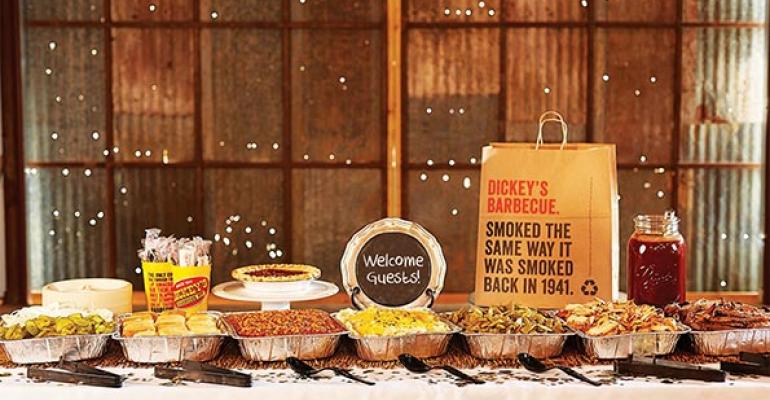Quick-service and casual-dining chains are stepping up their catering efforts as a way to generate additional revenue at a time when restaurant industry sales overall are growing only modestly.
Many operators are using catering services to appeal to guests’ sense of convenience, whether they are hosting a business meeting or a family event. Their efforts are beginning to pay off through the use of technology, dedicated teams and smart packaging.
“Table-service brands with an average check order under $15 are experiencing 5-percent sales increases, and establishments with higher check averages reported 10 percent or more of income from their catering businesses,” said Hudson Riehle, senior VP of the Research and Knowledge Group at the National Restaurant Association.

Riehle said catering is an “important component” for “operations focused on getting positive results.”
When Togo’s Eateries originally pursued offsite sales opportunities, “catering accounted for 5 percent of systemwide sales,” said Renae Scott, chief marketing officer of the 251-unit San Jose, Calif.-based operator. “Now this division accounts for 10 percent of sales, and it continues to gain traction and volume. We continue expanding our focus on this segment, and it’s paying off.”
Riehle of the NRA credits several factors for increased momentum across catering endeavors, including:
Technology. With the explosion of e-commerce and omni-channel retail experiences, brands are appealing to visitors’ growing demand for convenience by offering new, streamlined ordering options.
For example, McAlister’s Deli, a 330-unit chain, is beta-testing an online ordering platform to complement its growing catering business.
“As customers place orders on the digital platform, they also choose the restaurant location closest to them. The platform filters the order to this restaurant, which fulfills the order,” said Donna Josephson, CMO at the Alpharetta, Ga.-based operator.
“Hospitality is a brand differentiator for us, and whether shoppers visit us online or in person, we want to be sure to provide a personalized guest experience,” she said.
Josephson expects the platform to formally launch in the fourth quarter.
Dallas-based Dickey’s Barbecue Restaurants is upping the multichannel ante further with the power of a dedicated hotline. Launched three years ago, the chain’s hotline, 1-866-BARBECUE, which enables guests to directly place orders with live catering experts seven days a week, has grown into an important revenue stream.
“The hotline fields 2,500 calls and inquiries across 40 states monthly, and we expect the channel to be responsible for more than 15 percent of the organization’s overall sales” in 2014, said Andy Abbajay, chief operating officer at Dickey’s. “It is another vehicle that allows us to get our meals in people’s hands.”
The service augments the 450-unit chain’s in-store and online ordering services.
Togo’s plans to launch a call center in conjunction with opening its first Colorado location in November. As customers place their order with the call center, orders are funneled directly to the consumer’s local location, which fulfills and delivers the order.
Catering considerations
(Continued from page 1)
Innovative packaging. As brands pursue new ways to expand catering businesses, packaging is an important concern.
“The key is to use packaging that maintains the great taste of the product, preserves product integrity and quality while being transported, and cuts down on waste,” said McAlister’s Josephson.
Cutting waste goes straight to the bottom line, but the idea also resonates with today’s eco-conscious customer. These issues have prompted companies like Togo’s to adopt more eco-friendly packaging designs. McAlister’s is also considering innovative packaging “that allows us to meet the needs of our customers, not just from delivering a superior product, but also from sustainability points-of-view,” Josephson said, adding new packaging will roll out over the next 12 to 24 months.
Dedicated catering teams. With a specific team focused on the nuances of their brand’s catering division, organizations are primed to extend the breadth of the business and further drive sales. McAlister’s recently appointed a catering brand manager to its corporate executive team. This executive is responsible for developing new products and delivering these innovations to the restaurant, and ultimately, the customer.
“By creating such a robust catering pipeline, we also have a resource to determine how to expand our menus,” Josephson said. “For example, some catering items may do well on our regular menu, and vice versa. Our brand manager is in tune to [menu] trends, and works with our locations to understand how customer demand can shape flavors and overall business expansion.”
Dickey’s team works with franchisees to hone catering skills. In fact, the chain requires franchisees to invest up to 25 percent of their training with its dedicated catering team “so they can learn how to become a catering expert within their own store,” Abbajay said. “This additional education is paramount to driving the catering business, and marketing our brand’s service to the community.”
As companies look to further differentiate their catering brands, NRA’s Riehle suggests there is room to grow for enterprising brands.
“It's all about addressing consumers' need for convenience and in essence, finding ways to bring the restaurant to the consumer," Riehle said. "The growth of mobile food service, such as food trucks, is an example of this. If restaurants start thinking of the number of meal periods in a week, and use innovative concepts, including technology and new packaging options, to promote additional meal periods to consumers either at home or their places of business, there is plenty of potential to further evolve catering.”





